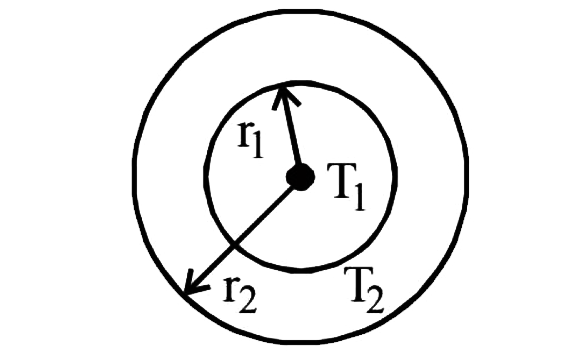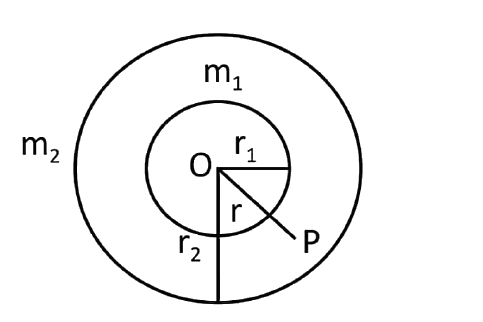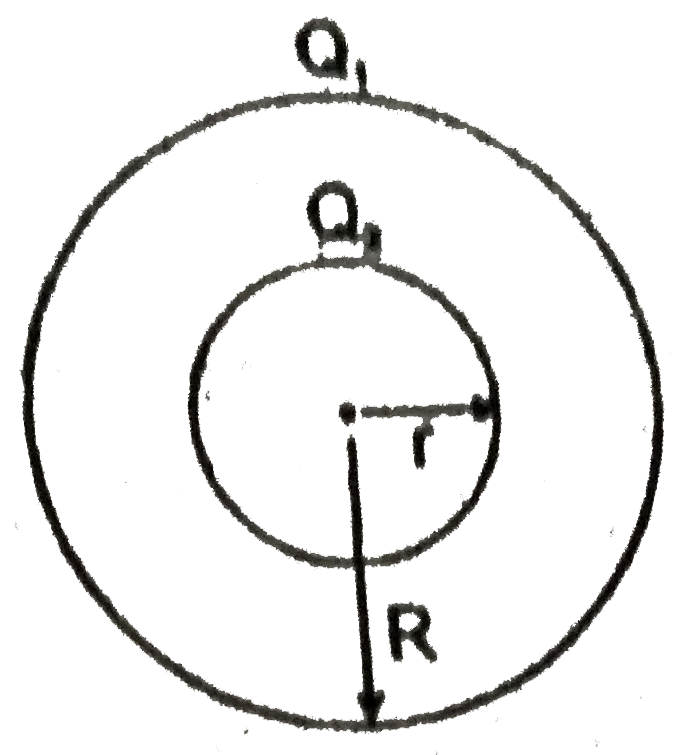A system consists of two concentric spherical shells of radii a and b(b>a) maintained at tempareture T1 and T2 respectively.The radial rate of flow of heat through subtance between the two concentric spherical shells is proportional to
b - a
abb−a
loge(ba)
b−aab
The correct Answer is:B
To find the radial rate of flow of heat through the substance between two concentric spherical shells of radii a and b (where b>a) maintained at temperatures T1 and T2 respectively, we can follow these steps:
1. Understand the Concept:
The heat transfer through the spherical shells can be analyzed using Fourier's law of heat conduction. The law states that the rate of heat transfer Q is proportional to the negative gradient of temperature and the area through which heat is being transferred.
2. Set Up the Equation:
According to Fourier's law:
Q=−k⋅A⋅dTdr
where k is the thermal conductivity, A is the surface area, and dTdr is the temperature gradient.
3. Determine the Area:
For a spherical shell at a distance r from the center, the area A is given by:
A=4πr2
4. Substitute the Area into the Equation:
Substitute A into the heat transfer equation:
Q=−k⋅4πr2⋅dTdr
5. Rearranging the Equation:
Rearranging gives:
dTdr=−Q4πkr2
6. Integrate the Equation:
We need to integrate this equation from r=a to r=b and from T=T1 to T=T2:
∫T2T1dT=−Q4πk∫ba1r2dr
7. Calculate the Integral:
The integral ∫1r2dr=−1r. Evaluating this from a to b:
−(−1b+1a)=1a−1b=b−aab
8. Substituting Back:
Substituting this back into the equation gives:
T2−T1=−Q4πk⋅b−aab
Rearranging gives:
Q=4πk(T1−T2)abb−a
9. Conclusion:
From this expression, we can conclude that the radial rate of flow of heat Q is directly proportional to abb−a.
Final Answer:
The radial rate of flow of heat through the substance between the two concentric spherical shells is proportional to abb−a.
The heat transfer through the spherical shells can be analyzed using Fourier's law of heat conduction. The law states that the rate of heat transfer Q is proportional to the negative gradient of temperature and the area through which heat is being transferred.
According to Fourier's law:
Q=−k⋅A⋅dTdr
where k is the thermal conductivity, A is the surface area, and dTdr is the temperature gradient.
For a spherical shell at a distance r from the center, the area A is given by:
A=4πr2
Substitute A into the heat transfer equation:
Q=−k⋅4πr2⋅dTdr
Rearranging gives:
dTdr=−Q4πkr2
We need to integrate this equation from r=a to r=b and from T=T1 to T=T2:
∫T2T1dT=−Q4πk∫ba1r2dr
The integral ∫1r2dr=−1r. Evaluating this from a to b:
−(−1b+1a)=1a−1b=b−aab
Substituting this back into the equation gives:
T2−T1=−Q4πk⋅b−aab
Rearranging gives:
Q=4πk(T1−T2)abb−a
From this expression, we can conclude that the radial rate of flow of heat Q is directly proportional to abb−a.
The radial rate of flow of heat through the substance between the two concentric spherical shells is proportional to abb−a.
Similar Questions
The figure shows a system of two concentric spheres of radii r1andr2 are kept at temperature T1andT2, respectively. The radial rate of flow of heat in a substance between the two concentric spheres is proportional to

View SolutionThe figure shows a system of two concentric spheres of radii r 1 and r 2 and kept at temperature T 1 and T 2 , respectively. The radial rate of flow of heat in a substance between the two concentric spheres, is proportional to:
View SolutionThe capacitance of two concentric spherical shells of radii R1 and R2(R2>R1) is
View SolutionTwo concentric conducting spherical shells of radii a1anda2(a2>a1) are charged to potentials ϕ1 and ϕ2, respectively. Find the charge on the inner shell.
View SolutionTwo concentric conducting shells of radii R and 2R are having charges Q and -2Q respectively.In a region r
View SolutionTwo concentric spherical conducting shells of radii r and R (r<R) carry charges q and Q respectively . The two shells are now connected by a conducting wire. The final charge on the inner shell is
View SolutionTwo concentric spherical shells of masses and radii m1,r1andm2,r2 respectively are as shown. The gravitational field intensity at point P is

View SolutionTwo uniformly charged concentric spherical shells of radius R and r, are given charges Q1 and Q2 respectively. If their potential difference is V, then it will not depends upon:

View SolutionTwo concentric spherical conducting shells of radii R and 2R are carrying charges q and 2q, respectively. Both are now connected by a conducting wire. Find the change in electric potential (inV) on the outer shell.
View SolutionTwo concentric spherical shells of radius R1 and R2(R2>R1) are having uniformly distributed charges Q1 and Q2 respectively. Find out total energy of the system.

View Solution
